Mobile Observation of Air Temperature and Humidity Distributions under Summer Sea Breezes in the Central Area of Osaka City
Abstract
1. Introduction
2. Methods
2.1. Objective Area
2.2. Mobile and Stationary Observations
2.3. Data Corrections and Mapping
3. Results and Discussion
3.1. Overview of Weather on the Observation Dates
3.2. Temperature and Humidity Distributions in the Objective Area
3.3. Characteristic of Upper Wind and River Surface Temperature
4. Conclusions
Author Contributions
Funding
Acknowledgments
Conflicts of Interest
References
- Oke, T.R. Boundary Layer Climates, 2nd ed.; Routledge: London, UK, 1987. [Google Scholar]
- Komatsu, H. Evaluation of recent hot summer in Kansai: Basic information for supply and demand of electricity. Jpn. J. Biometeorol. 2014, 51, 37–47. [Google Scholar]
- Ono, M. Chapter 3-Heat stroke in the summer of 2010. In Meteorological Research Note; The Meteorological Society of Japan: Tokyo, Japan, 2012; Volume 225, pp. 29–35. [Google Scholar]
- Yokoyama, T.; Fukuoka, T. Regional tendency of heat disorders in Japan. Jpn. J. Biometeorol. 2006, 43, 145–151. [Google Scholar]
- Hoshi, A.; Nakai, S.; Kaneda, E.; Yamamoto, T.; Inaba, Y. Regional characteristics in the death due to heat disorders in Japan. Jpn. J. Biometeorol. 2010, 47, 175–184. [Google Scholar]
- Fujibe, F. Long-term variations in heat mortality and summer temperature in Japan. Tenki 2013, 60, 371–381. [Google Scholar]
- Fujibe, F. Evaluation of background and urban warming trends based on centennial temperature data in Japan. Pap. Meteorol. Geophys. 2012, 63, 43–56. [Google Scholar] [CrossRef]
- Ono, M.; Ueda, K. Chapter 16—Prediction of heat stroke damage by global warming. In Meteorological Research Note; The Meteorological Society of Japan: Tokyo, Japan, 2012; Volume 225, pp. 177–182. [Google Scholar]
- Adachi, A.S.; Kimura, F.; Kusaka, H.; Inoue, T.; Ueda, H. Comparison of the impact of global climate changes and urbanization on summertime future climate in the Tokyo metropolitan area. J. Appl. Meteorol. 2012, 51, 1441–1454. [Google Scholar] [CrossRef]
- Ministry of the Environment, Government of Japan. Heat Stress Index: WBGT, Heat Illness Prevention Information (Online). Available online: http://www.wbgt.env.go.jp/en/ (accessed on 1 July 2020).
- Kono, H.; Narumi, D.; Shimoda, Y. Osaka, Klimaatlas for Urban Environment; Gyosei Co.: Tokyo, Japan, 2000; pp. 53–65. [Google Scholar]
- Fire and Disaster Management Agency. Heatstroke Information. Available online: https://www.fdma.go.jp/disaster/heatstroke/post1.html (accessed on 1 October 2020).
- Osaka City, “Kaze-no-Michi” Vision [Basic Policy]. 2011. Available online: http://www.city.osaka.lg.jp/kankyo/page/0000123906.html (accessed on 1 July 2020).
- Kubota, T.; Miura, M.; Tominaga, Y.; Mochida, A. Wind tunnel tests on the nature of regional wind flow in the 270 m square residential area, using the real model, Effects of arrangement and structural patterns of buildings on the nature of regional wind flow Part 1. J. Archit. Plan. Environ. Eng. 2000, 529, 109–116. [Google Scholar]
- Takebayashi, H.; Moriyama, M.; Miyake, K. Analysis on the relationship between properties of urban block and wind path in the street canyon for the use of the wind as the climate resources. J. Environ. Eng. 2009, 74, 77–82. [Google Scholar] [CrossRef][Green Version]
- Wong, M.S.; Nichol, J.E.; To, P.H.; Wang, J. A simple method for designation of urban ventilation corridors and its application to urban heat island analysis. Build. Environ. 2010, 45, 1880–1889. [Google Scholar] [CrossRef]
- Nabeshima, M.; Kozaki, Y.; Nakao, M.; Nishioka, M. Experimental study of heat island phenomena by mobile measurement system, Horizontal air temperature distribution at night in the Osaka plain. J. Heat Island Inst. Int. 2006, 1, 23–29. [Google Scholar]
- Mizuno, M.; Nabeshima, M.; Nakao, M.; Nishioka, M. Study on temperature distribution of an urbanized area using a vehicle with mobile measurement system: Analysis on characteristics of the 330 horizontal distribution using semivariogram and kriging. J. Environ. Eng. 2009, 74, 1179–1185. [Google Scholar] [CrossRef]
- Sahashi, K. Errors in the air temperature observation by traveling method with the automobiles: Effects of the automobiles. Tenki 1983, 30, 509–514. [Google Scholar]
- Melhuish, E.; Pedder, M. Observing an urban heat island by bicycle. Weather 1998, 53, 121–128. [Google Scholar] [CrossRef]
- Takayama, N.; Yamamoto, H.; Zhang, J.; Iwaya, K.; Wang, F.; Harada, Y.; Kaneishi, A.; Tsuchiya, Y.; Mori, H. Development and application of mobile observation method of urban climate to analyze occurrence of heat-island in Changchung city of China. Archit. Inst. Jpn. Technol. Des. 2009, 15, 827–832. [Google Scholar] [CrossRef]
- Brandsma, T.; Wolters, D. Measurement and statistical modeling of the urban heat island of the city of Utrecht (the Netherlands). J. Appl. Meteorol. Climatol. 2012, 51, 1046–1060. [Google Scholar] [CrossRef]
- Nakao, M.; Nabeshima, M.; Hasegawa, M.; Nishioka, M. Continuous mobile measurement method to estimate thermal environmental distribution in street. In Architectural Institute of Japan, Summaries of Technical Papers of Annual Meeting (Chugoku); Architectural Institute of Japan: Tokyo, Japan, 2008; pp. 981–982. [Google Scholar]
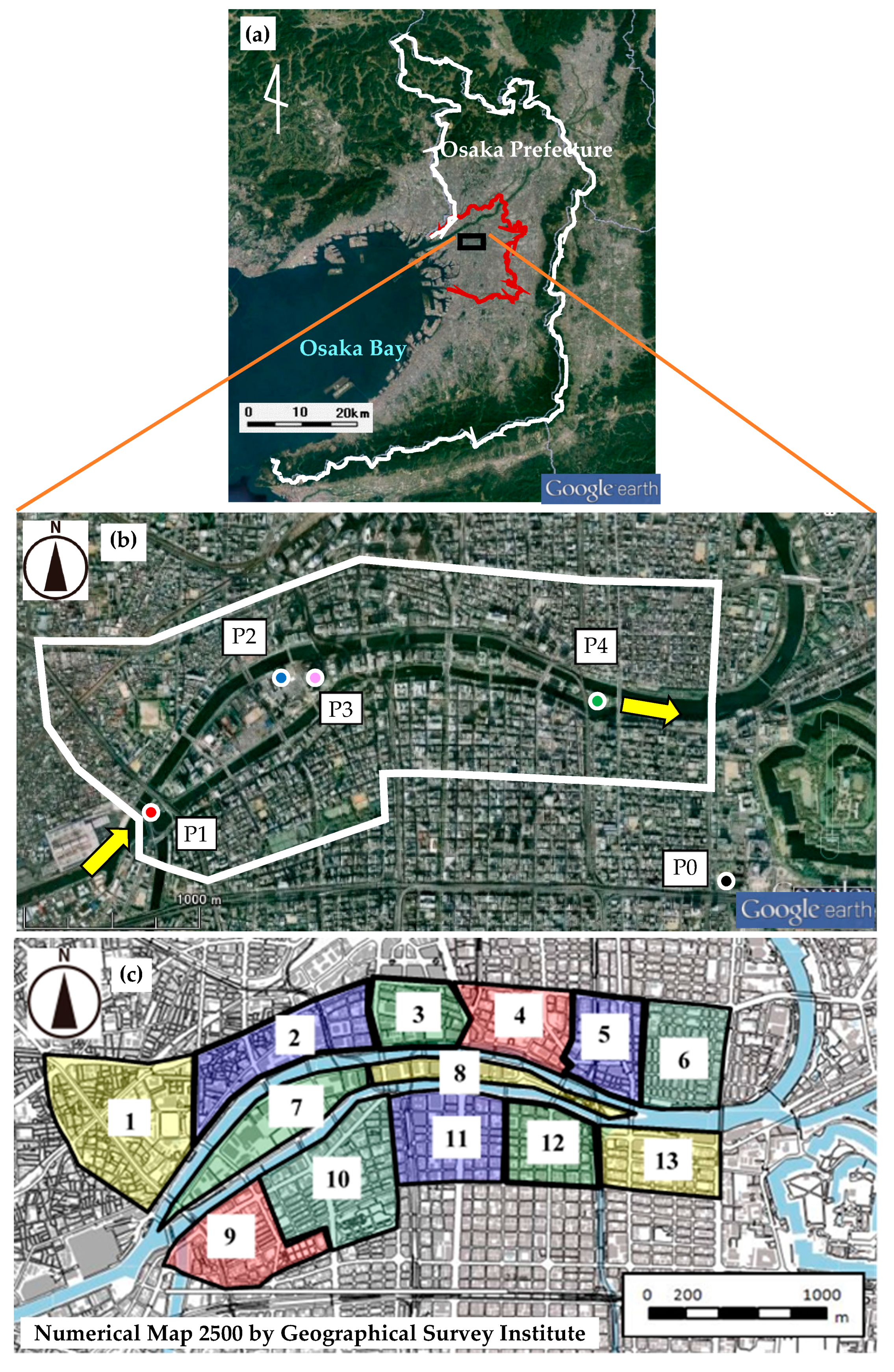
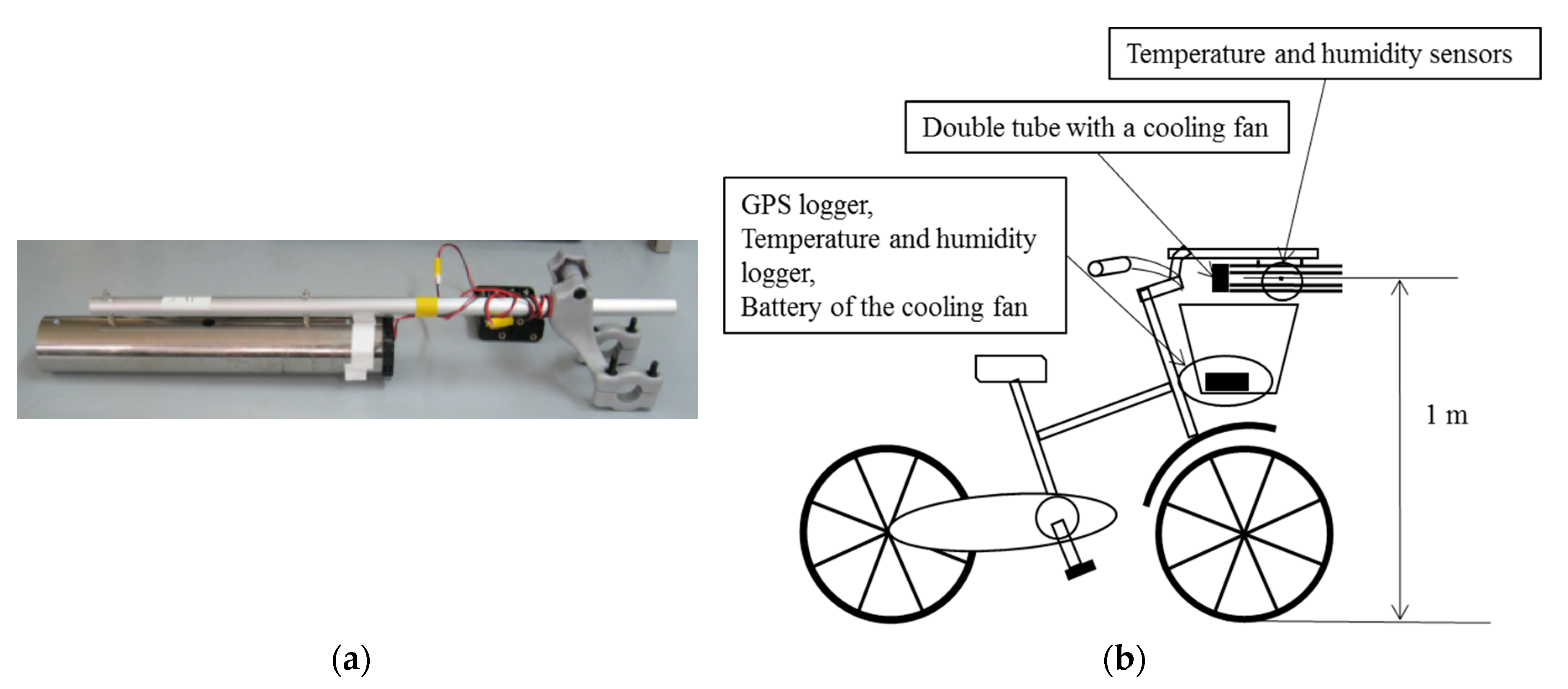
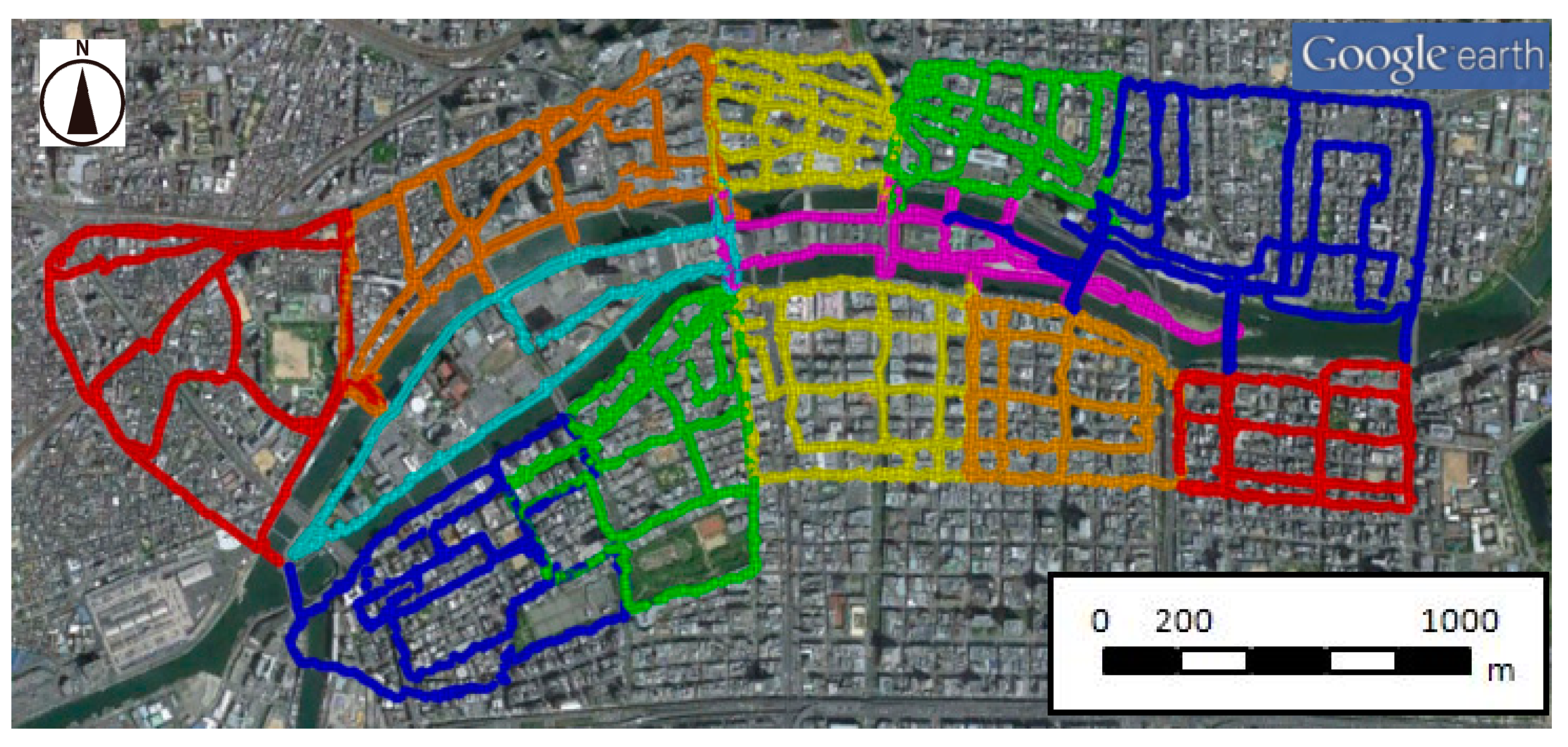
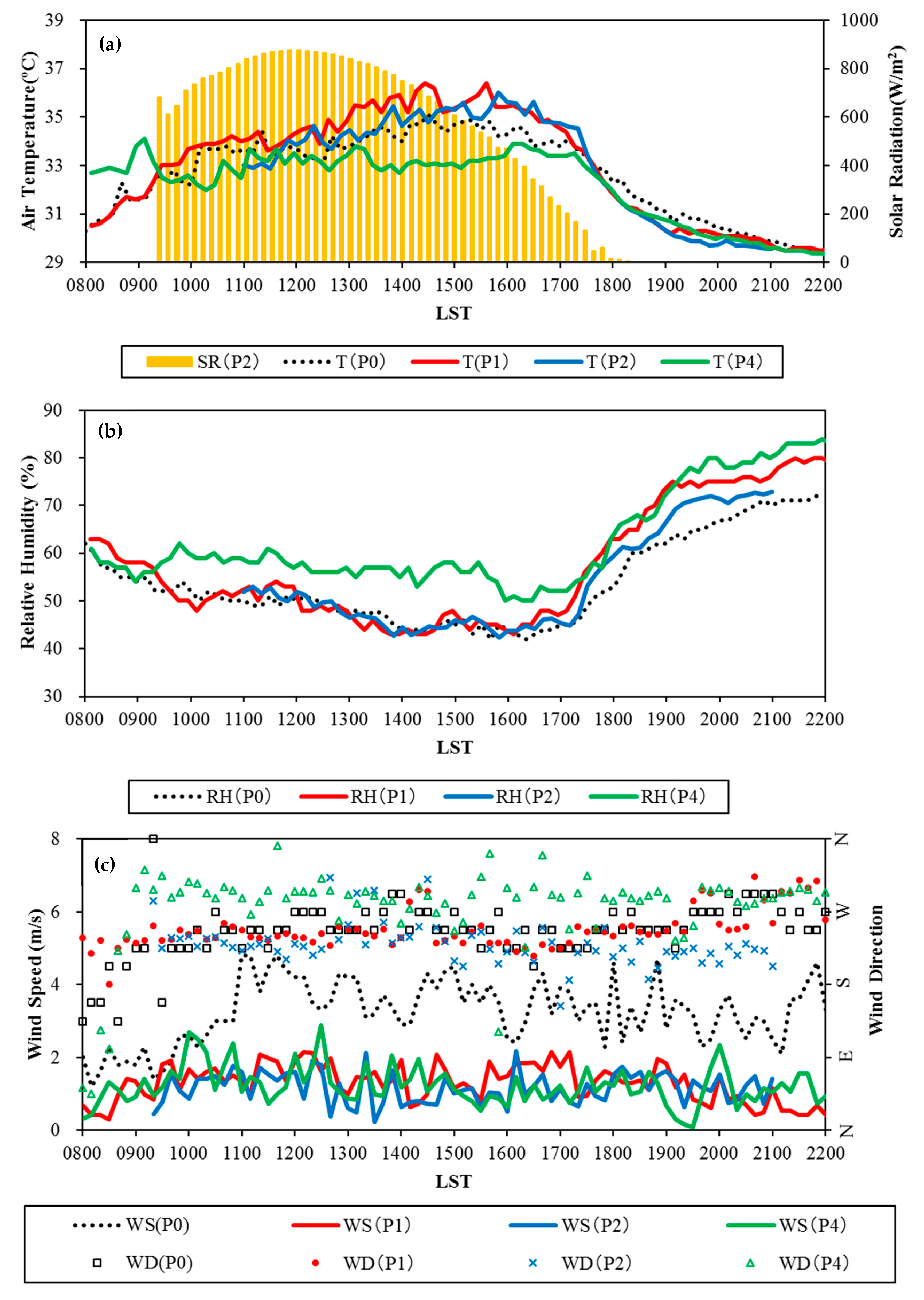



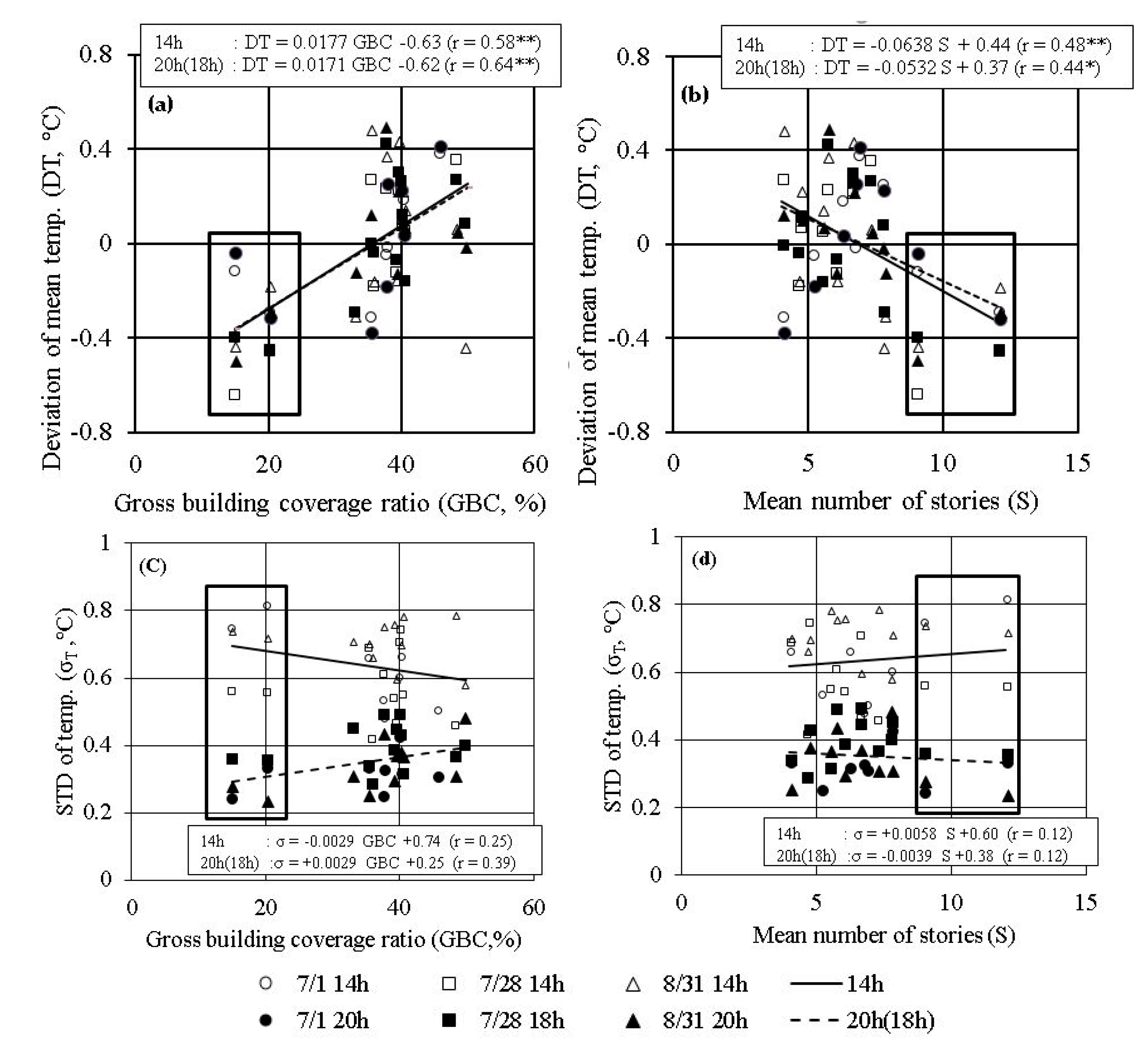
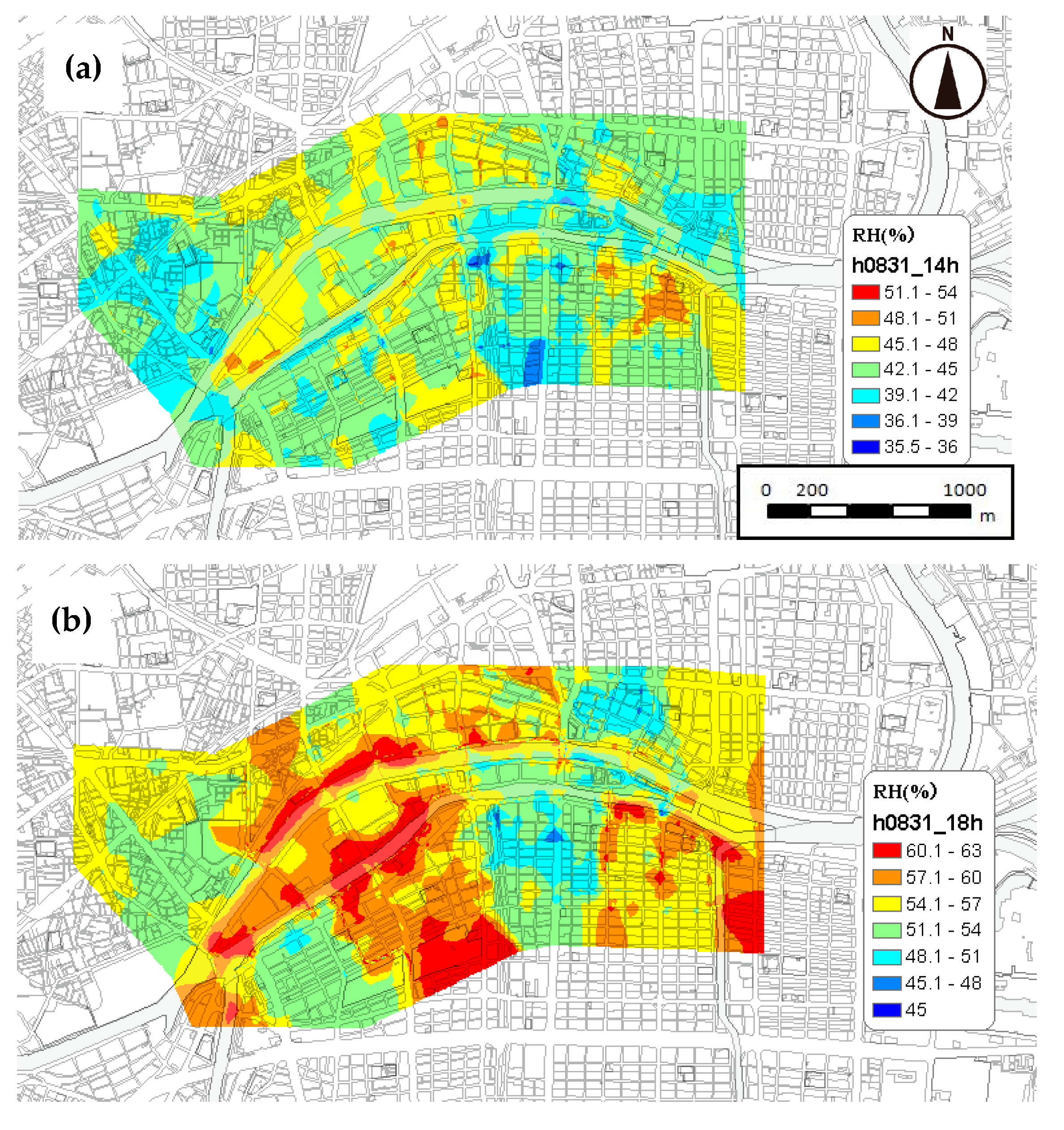
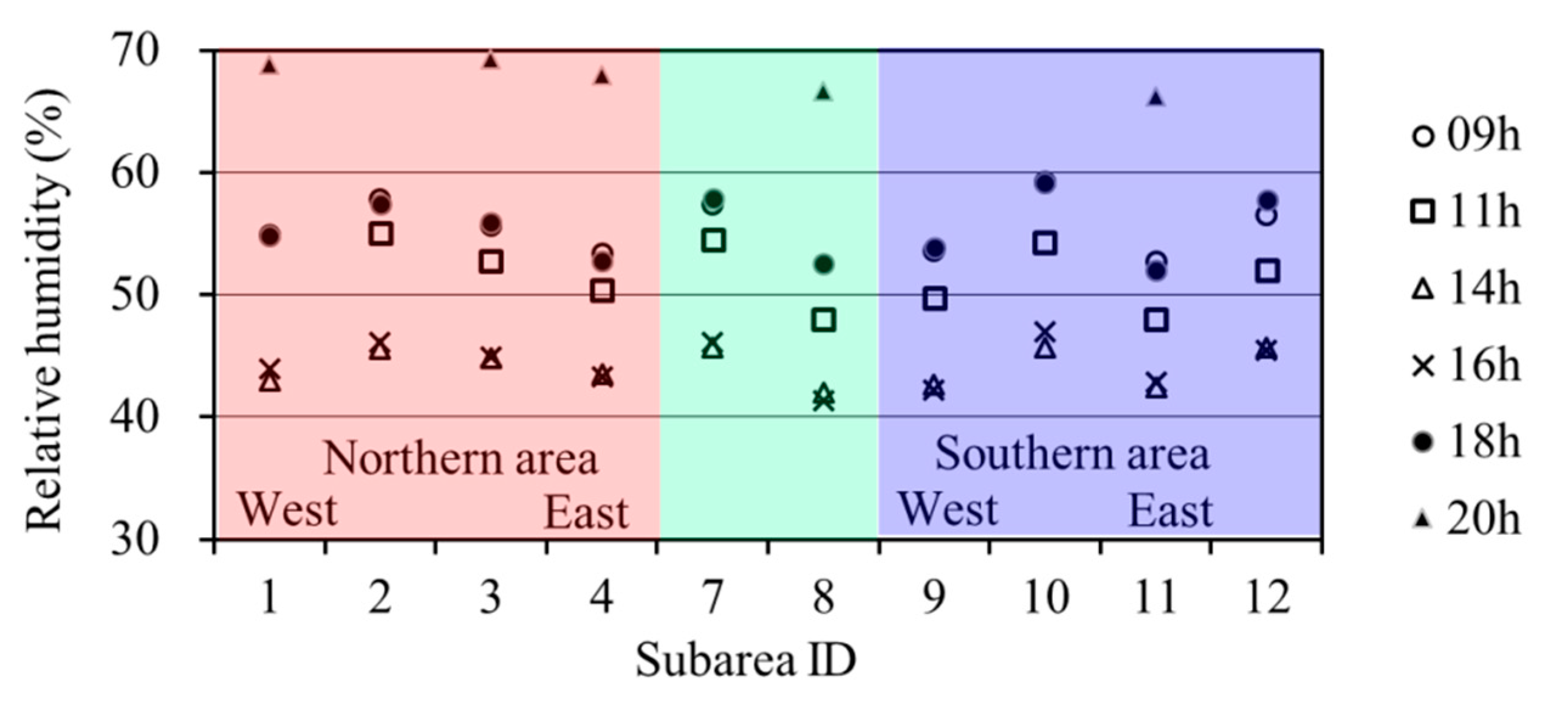
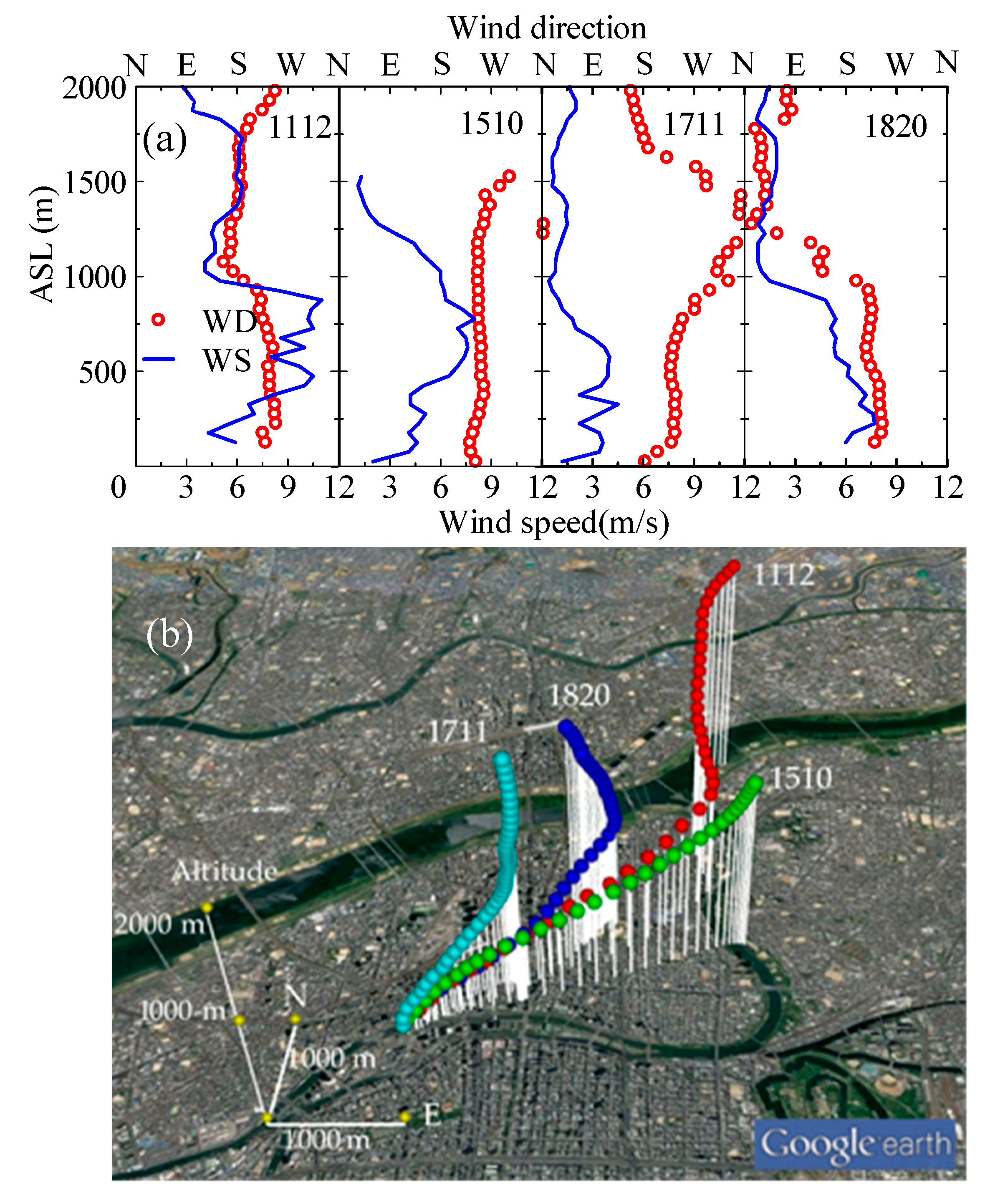
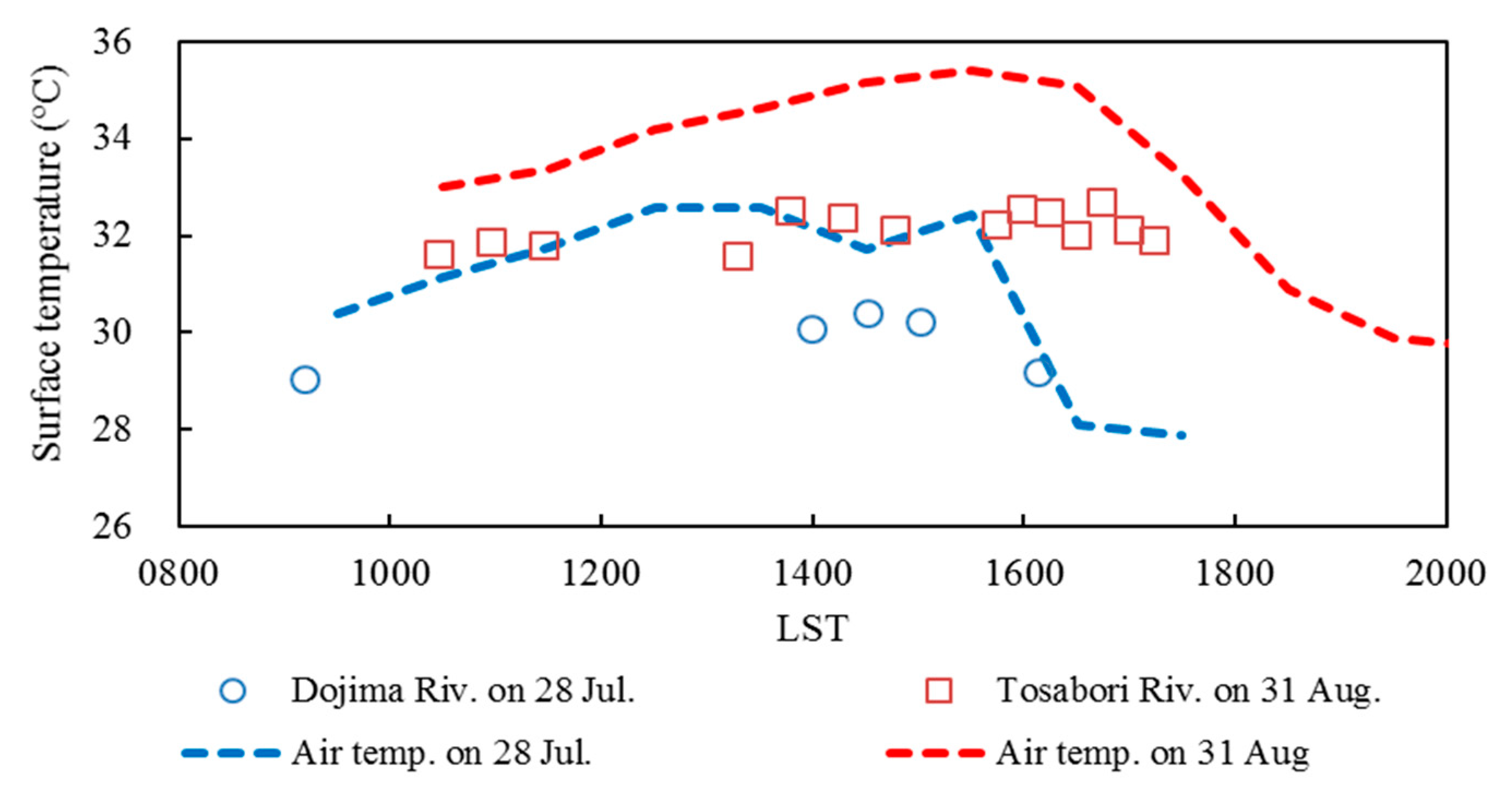
| Date | 1 July, 28 July, 31 August 2010 (3 days) |
| Start Time | 0900, 1100, 1400, 1600, 1800, 2000 LST (1 July and 31 August 2010) 0900, 1100. 1400, 1600, 1800 LST (28 July 2010) |
| Duration | 30–40 min/run |
| Instruments | Temperature-only; RTR-52A (T&D Co.) Thermistor type, Accuracy: ±0.3 °C Temperature/Relative humidity; RTR-53A (T&D Co.) Thermistor/Polymer type, Accuracy: ±0.3 °C/±5% Latitude and Longitude; eTrex H (Garmin Co.) GPS Accuracy: <10 m r.m.s. |
| Record Interval | 1 s |
| Date | 1 July, 28 July, 31 August 2010 (3 days) |
| Time | 0900-2100 LST |
| Height | 1.5 m AGL |
| Instruments | Temperature/Relative humidity; HMT100 (Visala Co.) Pt/Polymer type in a double tube with a ventilation fan Accuracy: ±0.3 °C at 30 °C/±1.7% RH Wind; USA-1 (EKO Co.) Ultrasonic type, Accuracy: ±0.01 m/s Short- and Long-wave radiations; CNR1-10 (Field pro Co.) Accuracy: daily total ±10% |
| Record Interval | 60 s |
Publisher’s Note: MDPI stays neutral with regard to jurisdictional claims in published maps and institutional affiliations. |
© 2020 by the authors. Licensee MDPI, Basel, Switzerland. This article is an open access article distributed under the terms and conditions of the Creative Commons Attribution (CC BY) license (http://creativecommons.org/licenses/by/4.0/).
Share and Cite
Yoshida, A.; Yasuda, R.; Kinoshita, S. Mobile Observation of Air Temperature and Humidity Distributions under Summer Sea Breezes in the Central Area of Osaka City. Atmosphere 2020, 11, 1234. https://doi.org/10.3390/atmos11111234
Yoshida A, Yasuda R, Kinoshita S. Mobile Observation of Air Temperature and Humidity Distributions under Summer Sea Breezes in the Central Area of Osaka City. Atmosphere. 2020; 11(11):1234. https://doi.org/10.3390/atmos11111234
Chicago/Turabian StyleYoshida, Atsumasa, Ryusuke Yasuda, and Shinichi Kinoshita. 2020. "Mobile Observation of Air Temperature and Humidity Distributions under Summer Sea Breezes in the Central Area of Osaka City" Atmosphere 11, no. 11: 1234. https://doi.org/10.3390/atmos11111234
APA StyleYoshida, A., Yasuda, R., & Kinoshita, S. (2020). Mobile Observation of Air Temperature and Humidity Distributions under Summer Sea Breezes in the Central Area of Osaka City. Atmosphere, 11(11), 1234. https://doi.org/10.3390/atmos11111234




